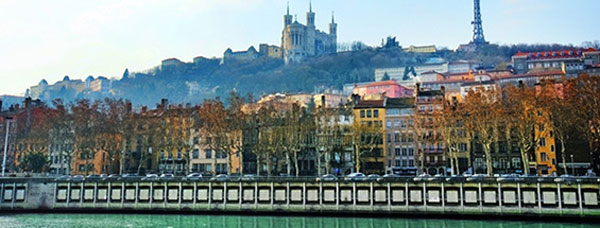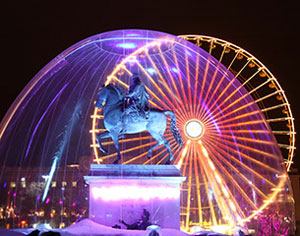Reply To:
Name - Reply Comment

From its earliest days, Lyon has been a point of passage. Lying at the junction of two mighty rivers, it was long known as a stopover between Paris and the Riviera and gateway to the Alps. But, scratch the surface and you’ll uncover a rich and diverse destination in its own right.
 Cuisine
Cuisine
Above all else, Lyon is a city obsessed with food. It is universally acknowledged as the culinary capital of France, a title not granted lightly. The keys to understanding Lyon’s unique gastronomic heritage are the two Bs: ‘bouchon’ and Bocuse.
A bouchon is a modest-but-legendary local bistro. Each year, about twenty are officially certified as upholding all the requisite standards and traditions. Look for the plaque with a blue-aproned marionette and the phrase ‘authentique bouchon lyonnais’ to ensure you’re getting the full bouchon experience.
The bouchons started out as female-run, working-class diners. When the French Revolution swept away the privileges of the upper classes, a legion of private cooks were suddenly out of work. These ‘mères lyonnaises’ (mothers of Lyon) opened small inns to feed the city’s silk workers. Through the years, women have continued to play an important role in feeding the city. In 1933, la Mère Brazier, became the first chef in the world to hold 6 Michelin stars.
Visit her eponymous restaurant in the Rue Royale for a taste of the traditional elevated to fine to haute cuisine standards.
Which brings us to a true national treasure, the man who lends his name to the most coveted culinary prize in the world, the Bocuse d’Or. It was under the watchful eye of la Mère Brazier that a young Paul Bocuse began his career in the kitchen. Years later, they say the term ‘nouvelle cuisine’ was first coined by a food critic in response to the meal Bocuse created for the maiden voyage of the supersonic Concorde in 1969.
Today, you can visit Bocuse’s 3 Michelin star restaurant outside the city at Pont au Collonges or four city-centre brasseries – Le Nord, Le Sud, l'Est and l'Ouest – each specialising in a different French regional cuisine.
Attractions
Lyon was traditionally known for producing and weaving the finest silks. To protect the precious fabric from rain as it was moved from workshop to showroom, a network of secret staircases and covered passageways was created. Centuries later, during World War II, the ‘traboules’ proved effective in protecting French resistance fighters from capture. Many are now open to the public, centred around the Old City and the Croix Rousse hillside.
To explore the hidden history of the city, visit the Tourist Office on Place Bellecour for a map highlighting all the traboules currently open to the public.
A celebration of light
The annual Fête des Lumières (Festival of Lights) is a four-day multimedia extravaganza with more than 80 public installations dazzling with futuristic building projections and laser light shows.
To catch the excitement, plan your visit to Lyon on and around 8th December.
The foundations of film
Two museums pay homage to the early days of cinema thanks to two of Lyon’s native sons. The Lumière brothers, Auguste and Louis, held the world’s first movie screening here, created with their new invention dubbed the Cinématographe. The 50-second film of workers leaving their father’s factory may not have won any awards, but it began a global love affair with motion pictures.
Today, you can visit the Musée Lumière in their converted home and the city hosts an annual film festival named in their honour. In the heart of the Old City, film buffs will find the truly unique Museum of Miniatures and Film Sets.
Flights to Lyon, France
Beyond Lyon
From the Fourvière hilltop, you can catch a glimpse of the majestic French Alps in the distance. In fact, they are less than two hours away by car or train and make a fantastic day trip. In winter, the nearest world-class ski resorts are Courchevel, Méribel and Chamonix. Or travel a bit further to the slopes of Europe’s tallest peak, Mont Blanc. In summer, the lake at Annecy is considered one of the most pristine and beautiful on the continent.
Train services run nearly every hour between Lyon and Annecy. To access ski areas in winter, book a bus transfer in advance that will take you directly from the airport to your resort.
Every French region has its wine and Lyon is the gateway to Beaujolais. In recent decades, the light-and-fruity libation has grown from a local curiosity to a global phenomenon.
Beaujolais is a ‘vin de primeur’, meaning it is meant to be enjoyed young. This being France, the production of wine is strictly controlled, right down to the date on which the year’s production can be released. Parisian restaurateurs began to compete to see who could be first to serve the season’s Beaujolais Nouveau. The race from vineyard to table was on. These days, wine enthusiasts from New York to Tokyo know the third Thursday in November as Beaujolais Nouveau Day.
The 140km Beaujolais Wine Route (‘Route des vins’) meanders through all ten of the leading Cru Beaujolais terroirs and the historic capital of the region, Beaujeu. Guided tours depart from Lyon, or hire a car and explore at your own pace.
Over 600 channels of on-demand entertainment, gourmet cuisine and award-winning service await you on every flight to Lyon. Enjoy First Class Private Suites, comfortable Business Class seating and convenient seatback electronic communication in Economy Class and throughout the aircraft.